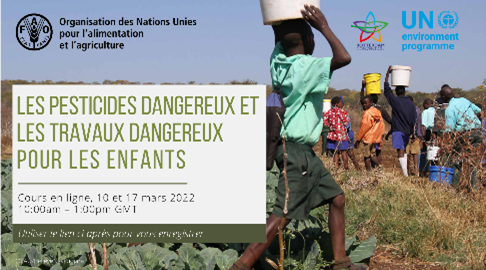Activities carried out in 2022
Long-standing collaboration with the Child Labour in Agriculture Prevention Team, sub-team of the Decent Rural Employment (DRE) Team in ESP
-
The Rotterdam Convention Secretariat and the Child Labour in Agriculture Prevention Team in FAO co-organized a special session on “Supporting a breakthrough against child labour and hazardous work in agriculture” during the 33rd International Congress on Occupational Health “Sharing solutions in occupational health through and beyond the pandemic” held from 6 to 10 February 2022. 1,400 delegates attended from 98 countries https://www.fao.org/childlabouragriculture/news-detail/international-congress-for-occupational-health-supporting-a-breakthrough-against-child-labour-in-agriculture/en
- Organization of a side event on “Children and their exposure to pesticides and other hazardous chemicals: strategies to reduce risks, as well as to protect and to promote their rights” on 16 June 2022 during BRS COPs in collaboration with the Office of the High Commissioner for Human Rights (OHCHR) and as panelists UNICEF, the DNA of Lebanon, the Child Rights International (CRIN), the Committee on the Rights of the Child, OHCHR, FAO and the International Union of Food, Agricultural, Hotel, Restaurant, Catering, Tobacco and Allied Workers' Associations (IUF)
- Organize together with ESP a course on “Addressing hazardous child labour and reduce risks posed to children by hazardous pesticides” for strengthening capacities of FAO personnel and national agricultural participants in the Ministries of Agriculture, Labour, Environment, Health, Designated National Authorities (DNAs) of the Rotterdam Convention, rural producers’ organizations and agricultural services, rural women organizations, departments of agriculture and extension, agricultural researchers, etc. Occasion to disseminate the two brochures on OSH. “Addressing hazardous child labour and reducing risks posed by hazardous pesticides” and The Information note and call for action “Eliminating hazardous child labour through safe and sustainable farming practices”

10 and 17 March (2 sessions of 3 hours) in RAF in French- Target countries: Mali, Burkina Faso, Cote d'Ivoire, Cameroon, Madagascar and Togo. Involvement of FAO RAF office - Plant Protection officer and Social Protection Officer participated. 60 participants.
https://www.pic.int/Default.aspx?tabid=4215&meetId=70B251A2-2A60-ED11-90C5-005056A3140F&lang=en
17 and 24 November 2022 (2 sessions of 3 hours) in Portuguese: target countries: Portuguese-speaking countries Angola, Cabo Verde, Guinea-Bissau, Mozambique, Sao Tomé and Principe in collaboration with CPLP – Community of Portuguese-speaking countries. 83 Participants.
https://www.pic.int/Implementation/CapacityDevelopment/Workshops/WorkshopOnline17Nov2022/tabid/9358/language/en-US/Default.aspx
- Support the preparation of the Thematic panel 9 - Making a breakthrough in agriculture to end child labour during the Fifth Global conference on the elimination of child labour in Durban (South Africa) on 15-20 May 2022. The high-level panel on agriculture is to give voice to global, regional, national and local actors who are contributing to address child labour in agriculture in different subsectors.
https://www.5thchildlabourconf.org/en/session/thematic-panel-9-making-breakthrough-agriculture-end-child-labour
- Development of a video ”Protecting children from pesticides” in six UN official languages and disseminate in FAO and BRS channels: https://www.youtube.com/watch?v=iwro9x7UT4o
- Translation and adaptation of two publications “Eliminating hazardous child labour through safe and sustainable farming practices” and “Addressing hazardous child labour and reducing risks posed by hazardous pesticides” in Arabic
- Support the Wageningen University on the development of a methodological framework on the use of blockchain technology for child labour monitoring and remediation in Ghana's cocoa production as children's exposure to pesticides is among the Key Data Elements under investigation.